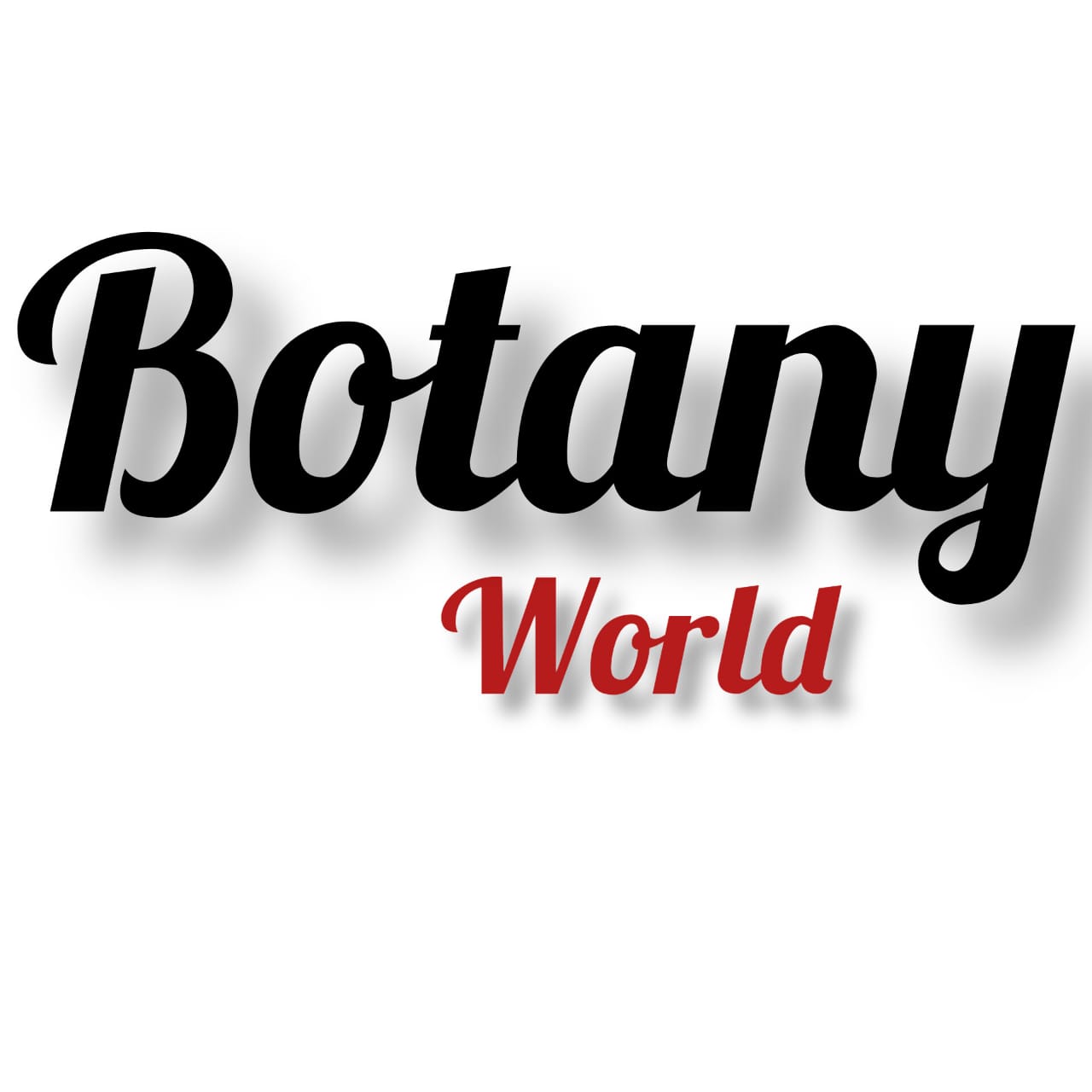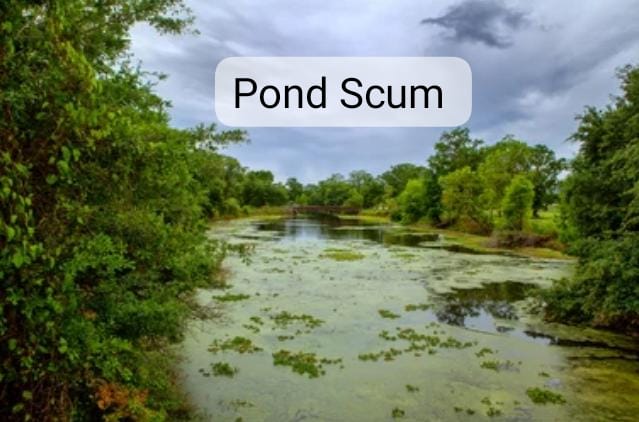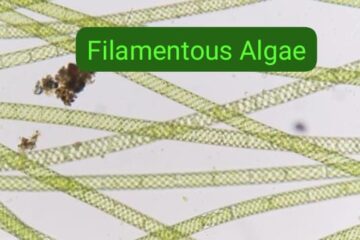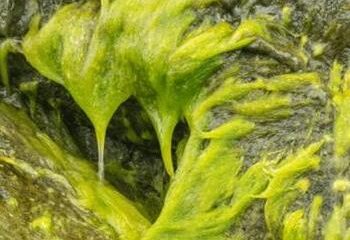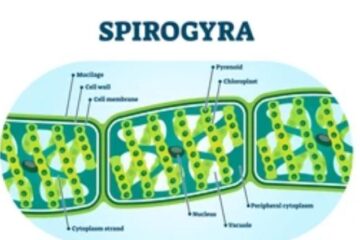Introduction
“Pond scum” is a colloquial term used to describe a layer or accumulation of various materials, such as algae, cyanobacteria, duckweed, watermeal, plant debris, and other floating substances, found on the surface of still or stagnant water bodies, like ponds, lakes, and slow-moving rivers.
While the term suggests a negative connotation due to its unappealing appearance, pond scum is a natural and regular occurrence in many aquatic environments. It consists of a diverse mixture of living organisms and non-living materials, often forming a thin or thick layer on the water’s surface. Pond scum can be green, brown, or bluish in color, depending on the specific organisms and materials present.
Pond scum can play an essential ecological role in aquatic ecosystems, including primary production through photosynthesis, nutrient cycling, habitat provision for various organisms, and water quality regulation. However, under certain conditions, excessive growth of algae or cyanobacteria can lead to algal blooms or harmful algal blooms (HABs), causing ecological imbalances and potential harm to aquatic life and human health.
The formation of pond scum can be influenced by various environmental factors, including nutrient availability, temperature, sunlight, water flow, and the presence of sediments. Proper management and understanding of the factors contributing to pond scum are essential for maintaining healthy and balanced aquatic ecosystems.
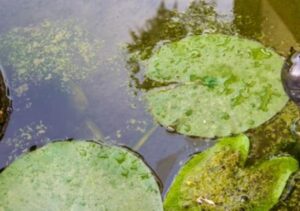
Pond scum isn’t always algae
“Pond scum” is a colloquial term that is often used to refer to various types of surface films or floating materials found in ponds and other stagnant water bodies. While algae are a common component of pond scum, it is not always exclusively composed of algae.
Pond scum can include a mix of different organisms, debris, and other materials floating on the water’s surface. In addition to algae, it may contain:
- Cyanobacteria: As mentioned earlier, cyanobacteria, also known as blue-green algae, are prokaryotic microorganisms that can form scum-like mats on the water’s surface.
- Duckweed: Duckweed is a type of floating aquatic plant that can form dense mats on the water, resembling pond scum.
- Watermeal: Watermeal is another floating aquatic plant that consists of tiny, free-floating green discs, which can form a layer that looks like a green scum on the water’s surface.
- Plant Debris: Dead leaves, twigs, and other plant material that fall into the water can accumulate on the surface and contribute to the appearance of pond scum.
- Pollen: During certain times of the year, especially spring and summer, pollen from nearby plants can fall into the water and form a layer on the surface, resembling a scum-like film.
- Foam: Natural foam can occur on the surface of ponds due to a variety of factors, including aeration, agitation, or the presence of certain substances.
The term “pond scum” is used informally and often refers to any unsightly or undesirable materials that accumulate on the surface of still or stagnant water bodies. While algae are an essential and common component of pond scum, it can also include a combination of various natural and anthropogenic materials.
It’s important to note that the presence of pond scum, regardless of its composition, can sometimes indicate imbalances or environmental issues in the water body. Excessive nutrient levels, pollution, or certain environmental conditions can lead to the overgrowth of algae or other floating materials, causing the formation of thick scum layers that may have adverse effects on aquatic ecosystems. Regular monitoring and proper management are necessary to maintain healthy and balanced aquatic environments.
Cyanobacteria and blue green algae
Cyanobacteria and blue-green algae are terms often used interchangeably to describe a group of photosynthetic microorganisms. However, it’s essential to understand their relationship and how they fit into the classification of living organisms.
- Cyanobacteria:
Cyanobacteria are a group of prokaryotic microorganisms, meaning they lack a membrane-bound nucleus and other organelles found in eukaryotic cells. Despite this difference, cyanobacteria are capable of carrying out photosynthesis, making them similar to algae in their ability to produce energy from sunlight.
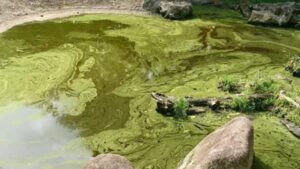
Cyanobacteria are ancient organisms, and their fossil record goes back billions of years, playing a significant role in shaping the Earth’s early atmosphere by producing oxygen through photosynthesis. They are often found in various aquatic environments, including freshwater lakes, ponds, rivers, and even in some marine habitats.
- Blue-Green Algae:
Blue-green algae is a colloquial term often used to refer to cyanobacteria. However, this term can be misleading, as cyanobacteria are not true algae. While they share the ability to photosynthesize and produce their own energy, algae are eukaryotic organisms with a distinct cellular structure, including a membrane-bound nucleus and other organelles.
The name “blue-green algae” arises from the bluish-green appearance of some cyanobacteria species when they form dense blooms in water bodies. These blooms can create scum-like mats on the water’s surface, leading to the common reference to “pond scum” associated with blue-green algae.
In summary, cyanobacteria and blue-green algae are closely related in their photosynthetic abilities and ecological roles. However, cyanobacteria are prokaryotic organisms, while true algae are eukaryotic organisms. Cyanobacteria are ancient, vital components of aquatic ecosystems, and their ability to perform photosynthesis has had a profound impact on the Earth’s history and the development of life as we know it.
duck weed and water meal
Duckweed and watermeal are both small, free-floating aquatic plants that belong to the Lemnaceae family. While they may appear similar, they are distinct species with unique characteristics. Here’s more information about each:
- Duckweed (Lemna spp.):
Duckweed is a common name for several species of small floating plants in the genus Lemna. These plants are among the smallest flowering plants on Earth. They have a simple structure, consisting of one or more flat, oval-shaped leaves (resembling duck’s feathers) and small root-like structures called “roots” or “roots hairs” that hang below the water’s surface.
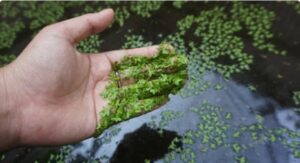
Duckweed can grow rapidly under favorable conditions, forming dense mats on the water’s surface. These mats can provide various ecological benefits, including serving as habitat and food for aquatic organisms. Additionally, duckweed can help improve water quality by absorbing excess nutrients such as nitrogen and phosphorus, thereby reducing the likelihood of algal blooms and eutrophication.
Due to its rapid growth and nutrient-absorbing capabilities, duckweed is sometimes used in wastewater treatment systems and as a potential feed source for livestock and fish.
- Watermeal (Wolffia spp.):
Watermeal is another member of the Lemnaceae family, and like duckweed, it is a free-floating aquatic plant. However, watermeal is even smaller and more minute than duckweed, with individual plants being just a few millimeters in size. Watermeal lacks true roots and instead floats freely on the water’s surface, with roots being absent or greatly reduced.
Watermeal can reproduce rapidly, forming greenish mats on the water’s surface. These tiny plants are often challenging to see individually but can accumulate in large numbers under suitable conditions.
Similar to duckweed, watermeal can be beneficial in improving water quality by absorbing excess nutrients. It provides habitat and food for various aquatic organisms as well.
Both duckweed and watermeal are essential components of aquatic ecosystems, contributing to nutrient cycling, providing shelter for small organisms, and assisting in water quality management. However, their rapid growth and ability to form dense mats can sometimes lead to concerns, such as obstruction of water flow and potential negative impacts on native species in some situations. Proper management and understanding their ecological roles are essential to ensure their positive contributions to aquatic environments.
Non algal components of pond scum
Pond scum can consist of various non-algal components, which contribute to the overall appearance and composition of the floating material on the water’s surface. While algae and cyanobacteria are common components of pond scum, other materials may also be present. Here are some non-algal components that can contribute to pond scum:
- Cyanobacteria (Blue–Green Algae): As mentioned earlier, cyanobacteria can form scum-like mats on the water’s surface and are often mistaken for algae due to their appearance. They are prokaryotic microorganisms capable of photosynthesis.
- Duckweed (Lemna spp.): Duckweed is a small, free-floating aquatic plant with flat, oval-shaped leaves. It can form dense mats on the water’s surface and is not a true algae but belongs to the Lemnaceae family.
- Watermeal (Wolffia spp.): Watermeal is another tiny, free-floating plant in the Lemnaceae family, consisting of extremely small individual plants that float on the water without true roots.
- Plant Debris: Dead leaves, twigs, and other plant material that fall into the water can accumulate on the surface and contribute to the appearance of pond scum.
- Pollen: During certain times of the year, especially spring and summer, pollen from nearby plants can fall into the water and form a layer on the surface, resembling a scum-like film.
- Foam: Natural foam can occur on the surface of ponds due to a variety of factors, including aeration, agitation, or the presence of certain substances. Foam is often composed of a mixture of organic and inorganic materials.
- Other Organic Matter: Decaying organic matter, such as dead algae, plants, or animals, can also contribute to the composition of pond scum.
- Anthropogenic Pollution: Human activities can introduce pollutants and debris into water bodies, including litter, oils, chemicals, and other substances, which may become part of pond scum.
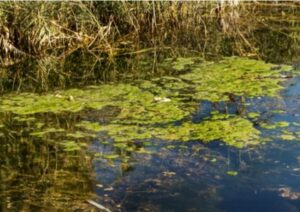
Environmental factors and pond scum formation
It’s important to note that the composition of pond scum can vary depending on the specific environmental conditions, the type of water body, and the prevailing sources of nutrients and pollutants. Additionally, the presence of pond scum, regardless of its composition, can sometimes indicate imbalances or environmental issues in the water body, highlighting the importance of monitoring and managing aquatic ecosystems to maintain their health and balance.
Pond scum formation is influenced by various environmental factors that can contribute to the growth and accumulation of algae, cyanobacteria, and other floating materials on the water’s surface. Understanding these factors is crucial for managing and mitigating excessive pond scum and maintaining healthy aquatic ecosystems. Some of the key environmental factors include:
- Nutrient Availability: The presence of nutrients, particularly nitrogen and phosphorus, is a critical factor in pond scum formation. Excessive levels of these nutrients can lead to eutrophication, promoting rapid algae and cyanobacteria growth, resulting in dense scum-like mats on the water’s surface.
- Temperature: Warmer temperatures generally promote the growth and reproduction of many algae and cyanobacteria species. In warmer climates or during the summer months, pond scum formation may increase due to the favorable conditions for these organisms.
- Sunlight: Algae and cyanobacteria rely on sunlight for photosynthesis, and the availability of sunlight plays a significant role in their growth. Clear and sunny conditions can enhance the growth of pond scum.
- Water pH: Algae and cyanobacteria have specific pH preferences for optimal growth. Changes in water pH can affect the composition of the aquatic community and influence the prevalence of certain scum-forming species.
- Water Flow and Mixing: Stagnant or slow-moving water bodies tend to accumulate more pond scum compared to well-mixed water bodies. Adequate water flow and mixing can help disperse and prevent the buildup of scum.
- Presence of Sediments: Nutrients and organic matter can accumulate in sediments at the bottom of the water body. When these sediments are disturbed, nutrients can be released into the water column, promoting algal and cyanobacterial growth.
- Anthropogenic Factors: Human activities can contribute to pond scum formation. Runoff from agricultural areas or urban landscapes can introduce excess nutrients, pesticides, and other pollutants into water bodies, exacerbating scum formation.
- Presence of Invasive Species: Invasive algae or plants can outcompete native species, leading to imbalances in the ecosystem and potentially increasing the occurrence of pond scum.
- Seasonal Variations: Seasonal changes in temperature, light availability, and nutrient inputs can lead to fluctuations in pond scum formation. In some regions, spring and summer months may be more favorable for pond scum growth due to increased nutrient runoff and warmer temperatures.
To manage pond scum and prevent its excessive formation, it’s essential to consider these environmental factors and implement appropriate measures. Strategies may include nutrient management, promoting water circulation, using environmentally-friendly agricultural practices, and limiting pollutant inputs to water bodies. Proper management can help maintain the ecological balance and health of aquatic ecosystems while minimizing the negative impacts of pond scum.
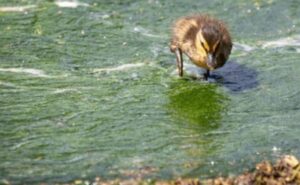
Impacts
Pond scum, particularly when it consists of excessive growth of algae or cyanobacteria, can have various impacts on aquatic ecosystems and the surrounding environment. Some of the significant impacts of pond scum include:
- Water Quality Degradation: Excessive growth of algae and cyanobacteria can lead to a phenomenon called algal blooms. These blooms can reduce water clarity, block sunlight from reaching submerged plants, and deplete dissolved oxygen levels, negatively affecting other aquatic organisms.
- Harmful Algal Blooms (HABs): Some species of cyanobacteria can produce toxins during certain conditions, leading to harmful algal blooms (HABs). These toxins can be harmful or even fatal to aquatic organisms, wildlife, and humans if they come into contact with or ingest contaminated water.
- Fish Kills: In severe cases of algal blooms or HABs, the rapid growth and decay of algae can lead to significant fluctuations in dissolved oxygen levels. When oxygen levels become critically low, it can result in fish kills, causing large numbers of fish and other aquatic organisms to die.
- Disruption of Aquatic Food Chains: Excessive pond scum can disrupt the natural balance of aquatic food chains. Algal blooms can lead to overpopulation of primary producers, like algae and cyanobacteria, which may, in turn, lead to an increase or decrease in herbivorous and predatory organisms.
- Loss of Biodiversity: Pond scum formation can lead to the loss of native aquatic plant species and negatively impact the diversity of aquatic life in the affected water body.
- Aesthetic and Recreational Issues: Dense mats of pond scum can create unsightly conditions in water bodies, reducing their aesthetic value and limiting recreational activities such as swimming, boating, and fishing.
- Economic Impact: Algal blooms and pond scum can have economic implications, such as decreased property values around affected water bodies, reduced tourism revenue, and increased costs associated with water treatment for potable water sources.
- Nutrient Cycling Disruptions: While algae can play a role in nutrient cycling, excessive growth can lead to imbalances and inefficient nutrient uptake. This can contribute to the accumulation of excess nutrients in the water, perpetuating a cycle of eutrophication and further promoting algal blooms.
- Negative Effects on Wildlife: Algal blooms and harmful toxins can harm aquatic organisms such as amphibians, invertebrates, and birds that rely on the water body for food and habitat.
- Public Health Concerns: Harmful algal blooms can pose health risks to humans through direct contact with contaminated water or the consumption of fish and shellfish that have been exposed to toxins.
To mitigate the impact of pond scum, it is essential to manage nutrient inputs, monitor water quality, promote environmentally-friendly practices, and implement strategies to prevent or control algal blooms and cyanobacterial proliferation. Proper management can help maintain the health and ecological balance of aquatic ecosystems, ensuring they continue to provide essential services and resources for both the environment and human communities.
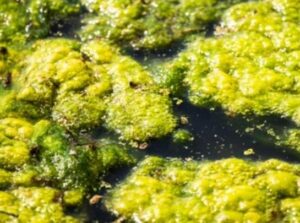
Natural pond scum and anthropogenic pond scum
Natural pond scum and anthropogenic (human-induced) pond scum refer to the formation and accumulation of floating materials on the water’s surface in aquatic environments. While both types can contribute to pond scum, their underlying causes and characteristics are different:
- Natural Pond Scum:
Natural pond scum results from ecological processes and interactions within the aquatic ecosystem. It can occur in both freshwater and marine environments and is a regular part of the natural cycles of nutrient dynamics. Some of the natural factors contributing to pond scum formation include:
Seasonal Variations: Changes in temperature, light availability, and nutrient inputs throughout the year can influence the growth of algae and other aquatic plants, leading to fluctuations in pond scum formation.
Nutrient Cycling: Algae and cyanobacteria play a vital role in nutrient cycling. They take up nutrients like nitrogen and phosphorus from the water, using them for growth and reproduction. During certain conditions, this nutrient uptake can lead to the rapid growth of pond scum.
Weather Events: Storms, heavy rainfall, or changes in water flow can disturb sediments and release nutrients, contributing to pond scum formation.
Indigenous Species: Indigenous algae and cyanobacteria can contribute to the natural formation of pond scum, supporting the ecological balance of the aquatic ecosystem.
- Anthropogenic Pond Scum:
Anthropogenic pond scum is primarily caused by human activities and is often associated with environmental pollution. Human-induced pond scum can result from the excess input of nutrients and other pollutants into water bodies. Some of the human-related factors contributing to pond scum formation include:
Nutrient Pollution: Agricultural runoff, untreated sewage, and industrial discharges can introduce excessive nutrients, such as nitrogen and phosphorus, into water bodies. This can lead to the proliferation of algae and cyanobacteria, resulting in algal blooms and pond scum.
Urbanization: Urban development can alter natural landscapes, leading to increased runoff of pollutants and nutrients into nearby water bodies, contributing to pond scum formation.
Stormwater Runoff: Impervious surfaces, such as roads and parking lots, can contribute to increased stormwater runoff, carrying pollutants and nutrients into water bodies.
Eutrophication: Anthropogenic activities that lead to eutrophication, a process of nutrient enrichment in water bodies, can cause excessive algal growth and pond scum formation.
Introduction of Non-Native Species: The introduction of invasive algae or plants can outcompete native species and contribute to the formation of pond scum.
To mitigate anthropogenic pond scum, it is essential to address the root causes of nutrient pollution, implement sustainable land use practices, and promote responsible waste management. Proper management can help reduce the negative impact of pond scum on aquatic ecosystems and protect water quality.
Ecological Importance
Pond scum, particularly when it consists of algae and cyanobacteria, plays a significant ecological role in aquatic ecosystems. Despite its unappealing appearance, pond scum serves several important functions and provides valuable contributions to the environment. Some of the ecological importance of pond scum includes:
- Primary Production: Algae and cyanobacteria in pond scum are primary producers that perform photosynthesis. They convert sunlight, carbon dioxide, and nutrients into organic compounds, mainly sugars, providing the foundation of the aquatic food chain. This process sustains the energy flow within the ecosystem, supporting various organisms, from tiny zooplankton to larger fish and wildlife.
- Nutrient Cycling: Pond scum, especially algae and cyanobacteria, is crucial for nutrient cycling in aquatic environments. These organisms absorb nutrients like nitrogen and phosphorus from the water, helping to regulate nutrient levels and preventing their excessive accumulation. The recycling of nutrients through pond scum ensures a continuous supply of essential elements for various life forms.
- Oxygen Production: As a result of photosynthesis, pond scum releases oxygen into the water, contributing to dissolved oxygen levels in the aquatic environment. Adequate oxygen is essential for the survival of aquatic organisms, including fish and other species that rely on oxygen for respiration.
- Habitat and Shelter: Pond scum provides habitat and shelter for numerous aquatic organisms, including small invertebrates, insects, microorganisms, and even juvenile fish. It offers a protective environment where these organisms can find refuge, feed, and reproduce.
- Water Quality Improvement: By absorbing nutrients, pond scum helps in improving water quality. Excess nutrients, especially nitrogen and phosphorus, can lead to eutrophication and algal blooms, degrading water quality and harming aquatic life. Pond scum helps to mitigate the impacts of nutrient pollution and maintain a healthier aquatic environment.
- Carbon Sequestration: Algae and cyanobacteria in pond scum sequester carbon dioxide from the atmosphere through photosynthesis. This process helps mitigate climate change by reducing the amount of carbon dioxide in the environment.
- Biodiversity Support: The presence of pond scum contributes to overall ecosystem diversity by providing various microhabitats and resources that support a wide range of aquatic organisms. Biodiversity is essential for the resilience and stability of ecosystems.
- Indicator of Environmental Health: The abundance and composition of pond scum can serve as an indicator of the health of aquatic ecosystems. Changes in the presence or type of pond scum can signal shifts in nutrient levels, water quality, and ecological balance, helping researchers and ecologists monitor the condition of water bodies.
Overall, pond scum, despite its colloquial name, plays a crucial ecological role in supporting the functioning and stability of aquatic ecosystems. Proper management and understanding of its significance are essential to ensure the health and sustainability of these environments.
Solution and mitigation
The solution and mitigation of pond scum involve implementing strategies to manage the factors that contribute to the excessive growth of algae, cyanobacteria, and other floating materials on the water’s surface. By addressing these underlying factors, it is possible to prevent or control pond scum and promote a healthier aquatic ecosystem. Some effective solutions and mitigation measures include:
- Nutrient Management: Implement practices to reduce nutrient inputs into water bodies, particularly nitrogen and phosphorus. This can include proper agricultural practices, minimizing the use of fertilizers near water bodies, and managing sewage and wastewater discharge.
- Vegetative Buffer Zones: Establishing vegetative buffer zones around water bodies can help trap and filter nutrients before they enter the water. Native vegetation along the shoreline can act as a natural buffer, reducing the potential for nutrient runoff and pond scum formation.
- Wetland Restoration: Wetlands act as natural filters and help remove excess nutrients from the water. Restoring and protecting wetland areas can assist in mitigating pond scum and improving water quality.
- Aerationand Mixing: Enhance water circulation and mixing to reduce stagnation. Installing aeration systems or using mechanical means to increase water movement can prevent the accumulation of pond scum.
- Algaecides and Biomanipulation: In some cases, targeted use of algaecides or biological controls can be employed to manage algae and cyanobacteria populations. Biomanipulation, such as introducing natural predators of algae-eating organisms, can also help control algal blooms.
- Phosphorus-Adsorbing Materials: The use of materials that can adsorb and remove phosphorus from the water can be effective in reducing nutrient availability and limiting algae growth.
- Dredging and Sediment Management: Removing excessive sediment from water bodies can help reduce the release of nutrients and other pollutants into the water, mitigating pond scum formation.
- Public Awareness and Education: Raise awareness about the impacts of pond scum and the importance of proper waste management, nutrient reduction, and sustainable practices among the public and stakeholders.
- Monitoring and Research: Regular monitoring of water quality, nutrient levels, and algal blooms is essential to detect changes and address issues promptly. Continuous research can also lead to improved understanding and more effective mitigation strategies.
- Policy and Regulation: Implement and enforce policies and regulations aimed at controlling nutrient runoff, pollution, and other factors contributing to pond scum formation.
It is important to note that the appropriate solution and mitigation measures may vary depending on the specific characteristics of the water body and the factors contributing to pond scum formation. A comprehensive and adaptive management approach that considers the unique conditions of each ecosystem is essential for successful pond scum control and the protection of aquatic environments.
In conclusion, the term “pond scum” is commonly used to describe various surface materials and floating substances found in ponds and other stagnant water bodies. While algae is a common component of pond scum, it is not the sole contributor. Other materials, such as cyanobacteria (blue-green algae), duckweed, watermeal, plant debris, pollen, foam, and even anthropogenic pollutants, can also contribute to pond scum formation.
Conclusion
Pond scum isn’t limited to a single organism or substance; instead, it represents a diverse collection of natural and human-induced materials present on the water’s surface. Each component plays a unique ecological role in aquatic ecosystems, contributing to nutrient cycling, habitat provision, primary production, and water quality regulation.
Understanding the various components of pond scum is essential for accurately assessing water body health and identifying potential environmental issues. Proper management and monitoring can help maintain a balanced and healthy aquatic environment, ensuring that pond scum’s ecological contributions remain positive while minimizing any adverse impacts that may arise from excessive growth or pollution.
Overall, recognizing the complexity of pond scum composition allows us to implement targeted measures to protect and preserve the health and diversity of aquatic ecosystems, ensuring they continue to thrive and serve as valuable resources for both wildlife and human communities.
